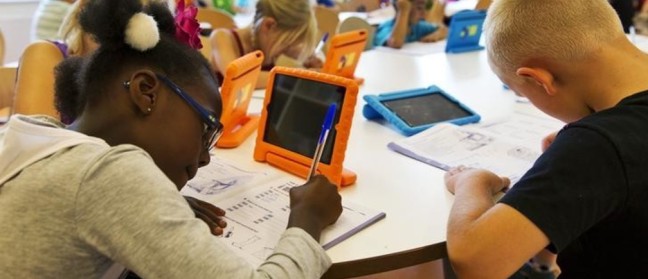
Today’s students see themselves as digital natives, the first generation to grow up surrounded by technology like smartphones, tablets and e-readers.
Teachers, parents and policymakers certainly acknowledge the growing influence of technology and have responded in kind. We’ve seen more investment in classroom technologies, with students now equipped with school-issued iPads and access to e-textbooks. In 2009, California passed a law requiring that all college textbooks be available in electronic form by 2020; in 2011, Florida lawmakers passed legislation requiring public schools to convert their textbooks to digital versions.
Given this trend, teachers, students, parents and policymakers might assume that students’ familiarity and preference for technology translates into better learning outcomes. But we’ve found that’s not necessarily true.
As researchers in learning and text comprehension, our recent work has focused on the differences between reading print and digital media. While new forms of classroom technology like digital textbooks are more accessible and portable, it would be wrong to assume that students will automatically be better served by digital reading simply because they prefer it.
Speed – at a cost
Our work has revealed a significant discrepancy. Students said they preferred and performed better when reading on screens. But their actual performance tended to suffer.
For example, from our review of research done since 1992, we found that students were able to better comprehend information in print for texts that were more than a page in length. This appears to be related to the disruptive effect that scrolling has on comprehension. We were also surprised to learn that few researchers tested different levels of comprehension or documented reading time in their studies of printed and digital texts.
To explore these patterns further, we conducted three studies that explored college students’ ability to comprehend information on paper and from screens.
Students first rated their medium preferences. After reading two passages, one online and one in print, these students then completed three tasks: Describe the main idea of the texts, list key points covered in the readings and provide any other relevant content they could recall. When they were done, we asked them to judge their comprehension performance.
Across the studies, the texts differed in length, and we collected varying data (e.g., reading time). Nonetheless, some key findings emerged that shed new light on the differences between reading printed and digital content:
Students overwhelming preferred to read digitally.
Reading was significantly faster online than in print.
Students judged their comprehension as better online than in print.
Paradoxically, overall comprehension was better for print versus digital reading.
The medium didn’t matter for general questions (like understanding the main idea of the text).
But when it came to specific questions, comprehension was significantly better when participants read printed texts.
Placing print in perspective
From these findings, there are some lessons that can be conveyed to policymakers, teachers, parents and students about print’s place in an increasingly digital world.
- Consider the purpose
We all read for many reasons. Sometimes we’re looking for an answer to a very specific question. Other times, we want to browse a newspaper for today’s headlines.
As we’re about to pick up an article or text in a printed or digital format, we should keep in mind why we’re reading. There’s likely to be a difference in which medium works best for which purpose.
In other words, there’s no “one medium fits all” approach.
- Analyze the task
One of the most consistent findings from our research is that, for some tasks, medium doesn’t seem to matter. If all students are being asked to do is to understand and remember the big idea or gist of what they’re reading, there’s no benefit in selecting one medium over another.
But when the reading assignment demands more engagement or deeper comprehension, students may be better off reading print. Teachers could make students aware that their ability to comprehend the assignment may be influenced by the medium they choose. This awareness could lessen the discrepancy we witnessed in students’ judgments of their performance vis-à-vis how they actually performed.
- Slow it down
In our third experiment, we were able to create meaningful profiles of college students based on the way they read and comprehended from printed and digital texts.
Among those profiles, we found a select group of undergraduates who actually comprehended better when they moved from print to digital. What distinguished this atypical group was that they actually read slower when the text was on the computer than when it was in a book. In other words, they didn’t take the ease of engaging with the digital text for granted. Using this select group as a model, students could possibly be taught or directed to fight the tendency to glide through online texts.
- Something that can’t be measured
There may be economic and environmental reasons to go paperless. But there’s clearly something important that would be lost with print’s demise.
In our academic lives, we have books and articles that we regularly return to. The dog-eared pages of these treasured readings contain lines of text etched with questions or reflections. It’s difficult to imagine a similar level of engagement with a digital text. There should probably always be a place for print in students’ academic lives – no matter how technologically savvy they become.
Of course, we realize that the march toward online reading will continue unabated. And we don’t want to downplay the many conveniences of online texts, which include breadth and speed of access.
Rather, our goal is simply to remind today’s digital natives – and those who shape their educational experiences – that there are significant costs and consequences to discounting the printed word’s value for learning and academic development.

 Valley. He is former Vice-President at Forrester Research, a leading US-based technology research and consulting firm. At Forrester, he investigated how globalised innovation – with the rise of India and China as both a source and market for innovations – is driving new market structures and organizational models called « Global Innovation Networks ». During his tenure at Forrester, he advised senior executives around the world on technology-enabled best practices to drive collaborative innovation, global supply chain integration, and proactive customer service. He served as the Executive Director of the Centre for India & Global Business at Judge Business School, University of Cambridge, where Jaideep Prabhu was the director.
Valley. He is former Vice-President at Forrester Research, a leading US-based technology research and consulting firm. At Forrester, he investigated how globalised innovation – with the rise of India and China as both a source and market for innovations – is driving new market structures and organizational models called « Global Innovation Networks ». During his tenure at Forrester, he advised senior executives around the world on technology-enabled best practices to drive collaborative innovation, global supply chain integration, and proactive customer service. He served as the Executive Director of the Centre for India & Global Business at Judge Business School, University of Cambridge, where Jaideep Prabhu was the director.